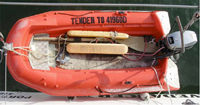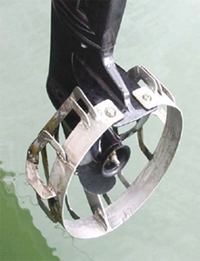Appropriate powered tender vessels and propeller guarding for rescue of recreational divers and snorkellers
Issued: 19 July 2005
Purpose
To alert employers, self employed persons, persons in control of workplaces, designers, importers, manufacturers, installers and suppliers of plant, and workers in the diving and snorkelling industry, to the hazards caused by using inappropriate vessels and unguarded propellers on motors of rescue vessels.
Background
There have been a number of incidents where the success of the rescue attempt has been compromised by the use of inappropriate vessels for the rescue of divers and snorkellers. There is also a risk of divers and snorkellers receiving severe injuries by coming into contact with unguarded propellers on rescue tender vessels.
Legislation
The Work Health and Safety Act 2011 provides a framework to protect the health, safety and welfare of all workers at work. It also protects the health and safety of all other people who might be affected by the work.
Find out more about the work health and safety laws.
Appropriate powered tender vessels
The Recreational Diving, Recreational Technical Diving and Snorkelling Code of Practice 2018 (PDF, 0.61 MB) states in section 2.2.3 Rescue of a person diving/snorkelling; "an appropriate powered tender vessel should be maintained in a ready condition, in the water for the purpose of rescue during diving or snorkelling operations".

Plate 1: An example of an appropriate powered tender vessel
Availability
If no powered tender is provided, then other ways must be adopted and followed that give the same level of protection against the risk. This can be tested by considering comparable rescue scenarios and establishing whether the system adopted provides a system of rescue that gives the same level of protection as having a powered tender vessel.
An example of this may be when the main diving vessel provides the same speed, availability and effectiveness of rescue as having a separate tender vessel. Typically larger vessels and sailing vessels would not be able to provide the same speed, availability and effectiveness of rescue as having a separate tender vessel.
Appropriateness
Any vessel used for diving and snorkelling rescue purposes must be appropriate for the task. The Plant Code of Practice states:
"You should ensure plant is only used where it is capable of performing safely within the design criteria and manufacturer's instructions."
Factors to consider include:
- Manoeuvrability and speed
- Draft
- Entry and Egress (Consideration should be given to potentially unconscious persons, tender crewing levels and stability)
- Line of sight between master of the tender and persons in the water
- Ability to safely transport an unconscious person
- Readiness for use.
Examples of appropriate tender styles include inflatable style vessels. Examples of inappropriate vessels include high-sided vessels and vessels with limited access points.
Propeller guards
The Plant Code of Practice states: "Where appropriate, risks associated with some hazards should be minimised through the use of guarding". It also states "The employer should ensure moving parts have suitable guarding. Where guarding of moving parts does not prevent the risk of entanglement, persons should not operate or pass in close proximity to the plant unless a barricade or safe system of work has been implemented to prevent or minimise the risk".

Plate 2: An example of a guarded outboard propeller
The Recreational Diving, Recreational Technical Diving and Snorkelling Code of Practice 2018 states in section 4.2.1 (g) Plant; "adequate and appropriate guarding is installed to prevent people coming into contact with moving parts, for example prop guards are attached to the motors of tenders and rescue vessels".
Powered vessels used for rescue purposes, and other vessels required to manoeuvre amongst divers and snorkellers should have propeller guards where appropriate.
Typically it is appropriate for outboard engines equal to or less than 30 hp to have permanently mounted propeller guards. It may not be practical to fit propeller guards to outboard engines greater than 30 hp for reasons of cavitation.
Where guarding is not practical, the employer should consider whether the vessel and engine type is suitable for use as a rescue vessel or to manoeuvre amongst divers and snorkellers. Other systems adopted must give the same level of protection against the risk. An example of this may be the physical separation of the propeller from divers and snorkellers where a tender vessel uses a marked and buoyed channel; or the use of guarded auxiliary outboard motor less than 30hp for manoeuvring amongst divers and snorkellers.
Planning and training
The Recreational Diving, Recreational Technical Diving and Snorkelling Code of Practice 2018 states in section 2.2.2 Emergency Plans advises that employers document emergency plans and that workers should be familiar with these plans.
The plans should cover:
- First aid
- Rescue
- Evacuation
- Missing Persons
In making workers familiar with these plans, it is recommended that regular practical training take place at the workplace.
Further Information
Contact Workplace Health and Safety Queensland's Diving Inspectors:
Principal Inspector Diving - Cairns 07 4048 1485
Senior Inspector Diving - Mackay 07 4967 4478
Senior Inspector Diving - Brisbane 07 3872 0677